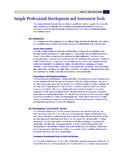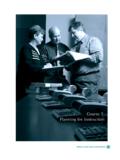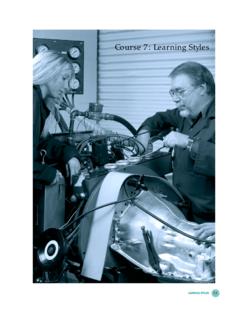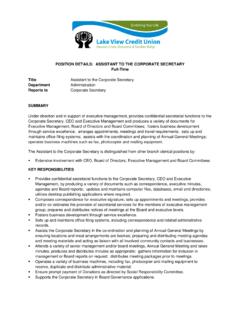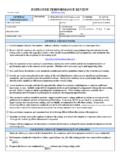Transcription of Course 1: Teaching & Facilitating Learning - Level I
1 Teaching and Facilitating Learning - Level ICURRICULUM GUIDE: Teaching & Facilitating Learning - Level 1: Teaching & Facilitating Learning - Level ICURRICULUM GUIDE: Teaching & Facilitating Learning - Level Standard: D:Provide student instructionKey and/or gather current instructional materials :Provide individual and group :Initiate, develop, and implement student instructional material and methods based on studentand industry assessments and & Facilitating Learning - Level I Editor s Note: Many professional-technical instructors are hired directly from industry andmay not have an extensive educational background in Teaching and Learning .
2 While thisentire guide may be helpful for all new and experienced instructors, this teacher s survival Course is a first step in orienting new instructors to their new role in the college courses in this guide ( Teaching and Facilitating Learning - Level II, Planning forInstruction, The Adult Learner, Learning Styles, Assessment for Learning ) will build upon thisprimary Course and delve more extensively into the skills and knowledge required by collegeinstructors in the State of Washington in the 21st century. The focus of this Level I Course andthe subsequent Level II is on standard D2: Provide individual and group instruction.
3 Level IIwill cover many of the same topics but in more depth and breadth and will emphasizefacilitation skills and assessing instructional DESCRIPTION:Teachers will begin or expand their training as a skilled professional-technical educator inthis introduction to vocational Teaching at the community college Level . Sometimes describedas a survival Course , this Course will help new or nearly new instructor-learners to establishthemselves as effective instructional leaders, communicators and facilitators in the profes-sional-technical classroom or laboratory setting. Instructor-learners will learn about success-ful beginnings, being a positive role model for their students, and developing effectivelessons based on identified student Learning outcomes and competencies.
4 New instructorlearners will practice implementing a variety of instructional strategies and student assess-ments and begin to learn ways to evaluate the progress of diverse learners to meet courseobjectives. Focus is on four primary modes of instruction: lecture, discussion, demonstra-tion, and small group work and ways in which instructors act as facilitators of Learning intheir classrooms. Instructor-learners will actively practice their Teaching skills to begin toimplement learner-centered instructional activities and lessons that they have OUTCOMES: The instructor-learner will: Model appropriate attitudes, behaviors and technical skills that maximize student learningand meet current workplace requirements and industry skill standards.
5 Design, deliver and/or facilitate well-organized learner-centered instructional activities andlessons that actively engage students and promote achievement of student learningoutcomes. Implement at least four instructional strategies (lecture, demonstration, discussion, smallgroup cooperative Learning ) that provide students regular opportunities to actively engagewith Course content to achieve Course and Facilitating Learning - Level ICURRICULUM GUIDE: Teaching & Facilitating Learning - Level OUTCOME ASSESSMENTS The instructor-learner will.
6 Develop and write an instructional activity or lesson plan that facilitates learningwith active learner involvement and aligns with stated student Learning outcomes. Demonstrate Teaching or Facilitating a lesson incorporating group and/or individualinstruction that effectively engages students and models current workplacerequirements and industry standards. Produce a Course syllabus that utilizes a variety of instructional strategies that meetthe Learning needs of diverse learners and provides opportunities for studentsadequately to practice, perform, and receive feedback on required skills, knowledgeand INDICATORS: Students are effectively oriented to the Learning task, including outcomes,assessments, syllabus, and prior and related skills and abilities.
7 Learning is facilitated with clear presentations, demonstrations, class discussionsand active learner involvement. Learning activities and lessons are directed toward program and student outcomesand competencies and industry standards. Lesson plans are organized to provide regular opportunities for students to activelypractice, perform, and received feedback on all required skills. Instruction promotes the application, transfer, and retention of Learning . Group and individual instruction accurately and effectively model and teach industrystandards and workplace requirements. Student questions and discussions are effectively acknowledged, guided andintegrated into the Learning process in a positive way.
8 Course syllabus contains essential information for student understanding of coursepolicies, Course content, and student AND SKILLS: The beginning instructor-learner will: Promote a positive Learning environment from the first day of class. Explain the role of the instructor as that of leader, facilitator, and role model. Demonstrate a basic understanding of the Learning process and of student-centeredlearning. Explain and present basic ideas and information and concepts in well-organizedspeech. Engage students with the Learning through at least four primary modes: lecture,demonstration, discussion and small groups.
9 Listen attentively, pose critical questions, and confirm and clarify communication. Demonstrate knowledge of the subject matter and competency in the field. Write Course objectives, competencies and/or specific student Learning outcomes. Write a Course syllabus containing essential information. Begin to develop, implement and demonstrate effective lesson planning. Begin to assess peer and own instructional effectiveness. Begin to develop effective Learning strategies for diverse GUIDE: Teaching & Facilitating Learning - Level THE FIRST DAYE ssential Content Discussion Topics and Key PointsInstructor s demeanor Teacher s behavior sets the tone for the Course .
10 Allow for self and student introductions. Allow for student stories and individual attention. students Find out student goals and expectations for the Course . Correlate student expectations with stated student learningoutcomes and Course content. Find out about the learners in the class before you get to the Day DO s Plan and rehearse first lesson. Be what you want students to be. Start out with high expectations of all students. Appear to be confident at all times. Have syllabus and/or first day expectations, grading criteria writtenout for students to have.

